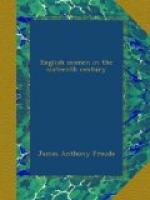The bond in its first form was a visible creation of despair. It implied a condition of things in which order would have ceased to exist. The lawyers, who, it is curious to observe, were generally in Mary Stuart’s interest, vehemently objected; yet so passionate was public feeling that it was signed throughout the kingdom, and Parliament was called to pass an Act which would secure the same object. Mary Stuart, at any rate, was not to benefit by the crimes either of herself or her admirers. It was provided that if the realm was invaded, or a rebellion instigated by or for any one pretending a title to the crown after the Queen’s death, such pretender should be disqualified for ever. In the event of the Queen’s assassination the government was to devolve on a Committee of Peers and Privy Councillors, who were to examine the particulars of the murder and execute the perpetrators and their accomplices; while, with a significant allusion, all Jesuits and seminary priests were required to leave the country instantly, under pain of death.
The House of Commons was heaving with emotion when the Act was sent up to the Peers. To give expression to their burning feelings Sir Christopher Hatton proposed that before they separated they should join him in a prayer for the Queen’s preservation. The 400 members all rose, and knelt on the floor of the House, repeating Hatton’s words after him, sentence by sentence.
Jesuits and seminary priests! Attempts have been made to justify the conspiracies against Elizabeth from what is called the persecution of the innocent enthusiasts who came from Rheims to preach the Catholic faith to the English people. Popular writers and speakers dwell on the executions of Campian and his friends as worse than the Smithfield burnings, and amidst general admiration and approval these martyred saints have been lately canonised. Their mission, it is said, was purely religious. Was it so? The chief article in the religion which they came to teach was the duty of obedience to the Pope, who had excommunicated the Queen, had absolved her subjects from their allegiance, and, by a relaxation of the Bull, had permitted them to pretend to loyalty ad illud tempus, till a Catholic army of deliverance should arrive. A Pope had sent a legate to Ireland, and was at that moment stirring up a bloody insurrection there.
But what these seminary priests were, and what their object was, will best appear from an account of the condition of England, drawn up for the use of the Pope and Philip, by Father Parsons, who was himself at the head of the mission. The date of it is 1585, almost simultaneous with the scene in Parliament which I have just been describing. The English refugees, from Cardinal Pole downwards, were the most active and passionate preachers of a Catholic crusade against England. They failed, but they have revenged themselves in history. Pole, Sanders, Allen, and Parsons have coloured all that we suppose ourselves




